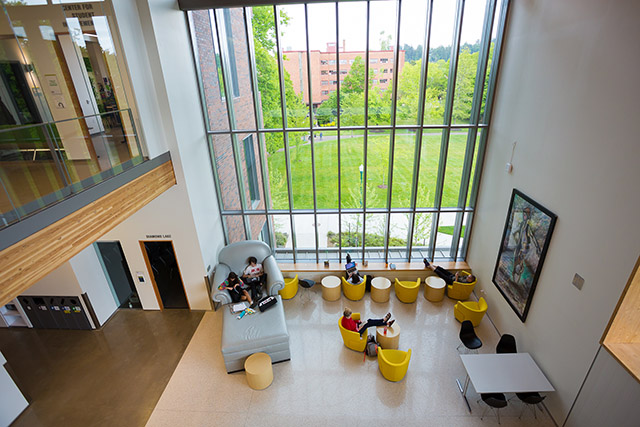Extending the Classroom
Learning is no longer restricted to the classroom or the library. Increasing the use and appeal of the space in between classrooms and other traditional learning environments can play a key role in teaching and learning.
Remember the days when learning only took place in a classroom or the school library? If so, you probably haven’t been on a college campus in the last few years.
Today, colleges and universities increasingly are recognizing that the spaces between traditional learning environments — from hallways and lounges to common areas — are no longer simply transitional spaces that students and faculty pass through as they go from one place to another. Rather, these formerly “empty” spaces can be instrumental in creating connections through simple interactions.
Such spaces have become an extension of the formal classroom, where additional learning and collaboration occur whenever students and faculty get together. They have become productive spaces where students can compare notes with each other, discuss assignments or review for tests or exams. Students can catch up with their teachers before or after classes to ask additional questions or clarify lecture content. Conversely, these are also important spaces for teachers and students to step out in order to take a break, rest and recharge.

Shuttterstock: Joshua Rainey Photography
By providing students and faculty with easy, adaptable ways to turn these spaces into environments they want to use, colleges and universities are creating an extension of formal learning spaces and offering more casual-learning common areas. As a result, these shared spaces should be considered with just as much scrutiny as a 21st-century classroom or faculty space as another means to improve and cultivate learning.
Reclaiming Underutilized Real Estate
Being able to easily settle in and make the space feel like it is their own, even when it is only on a small scale, helps students to get comfortable and, ultimately, is likely to increase the time they spend there. When people are comfortable, they are more likely to share their own ideas with their peers when working together on group projects. This, in turn, has the potential to result in increased and improved collaborations.
Since both individuals and groups use these areas, the spaces should have as much flexibility as possible. Students can be given choice and control over how they learn by providing them with the opportunity to move furniture around so that it will support both solo work and collaboration sessions for partner or larger group projects.
With that in mind, colleges should consider installing a variety of seating options so that students and educators can choose what setting will best support their different postures as they learn, collaborate, socialize, focus, or rest and recharge. Lounge, nested or stacked seating options will enable people to settle in and get comfortable for longer sessions that have a specific goal. Standing-height tables and chairs, on the other hand, will encourage people to walk up and connect with one another in a casual way for shorter conversations. Booth seating options can support both socialization and studying, as well as offer students and instructors a space with a little more privacy.
Another necessity, readily available analog and digital tools, provides students with the support they need for better collaboration. Work surfaces are necessary for holding books, laptops, tablets and other materials that they will need to reference. Whiteboards, tackable surfaces, screens with videoconferencing capabilities, WiFi and power sources will allow students to easily share ideas with one another, regardless of whether they are in the room or elsewhere in a remote location. When furniture with built-in power charging capabilities is incorporated, students will be more likely to linger for longer periods of time. Meeting students’ needs to keep their devices charged and easily share information will provide the space with added functionality.

Shutterstock: goodluz
When instructors provide time for breakout sessions during classes and students are instructed to collaborate for longer periods of time, they may leave the classroom setting in search of an area that better supports their group work. Supporting different postures and work styles can enhance their productivity as they share ideas.
Proximity plays an important role as well. If individuals feel like they are too close or too far — whether it is from other persons or the technology and tools in the area — they will be less likely to use the space.
Help Students and Faculty to Focus
While most transitional spaces are open areas where students and faculty move freely, colleges and universities are also recognizing that there is sometimes a need for quieter, more private areas — places to focus and complete assignments, review presentation notes one last time or prep for upcoming exams. Pods, enclosed spaces and other shielded settings can provide privacy and areas where students and staff can feel protected without feeling isolated from the hustle and bustle of a busy hallway.
To make these private areas even more functional and accommodating, colleges and universities are equipping them with sound-masking systems and speech privacy technology. Doing so allows students and staff to stay focused when they are working individually or in smaller groups.
Since these environments aren’t formal learning areas, students may be louder and more energetic upon exiting a classroom or lecture hall as they run into friends and peers who were in other classes. This can affect students who are already in the space, and potentially lead to a decrease in focus for individuals who are trying to finish an assignment before their next class begins or review notes with their group members. Sound-masking and speech privacy technology can mute the liveliness and energy of these spaces so students can remain focused on the task at hand.
Bottom line? Learning is no longer restricted to the classroom or the library. It is just as likely to take place anywhere on campus. Increasing the use of the space in between classrooms and other traditional learning environments can play a key role in helping both students and instructors to bring learning outside the classroom, while simultaneously taking full advantage of all of the university’s valuable real estate.
About the Author
Steven Lang is president & CEO of dancker (www.dancker.com), a leading interior solutions firm working with clients to create spaces that maximize the flow between people and ideas by providing seamless integration of architectural, furniture, technology and logistics solutions.